Optimization of a “Social-Ecological” System Pattern from the Perspective of Ecosystem Service Supply and Demand: A Case Study of Jilin Province
Abstract
1. Introduction
2. Study Area
3. Materials and Methods
3.1. Data Sources and Preprocessing
3.2. Research Methods
3.2.1. Ecosystem Service Supply
3.2.2. Ecological Source Determination—MSPA
3.2.3. Demand for Ecosystem Services
3.2.4. Circuit Theory
3.2.5. Construction of Landscape Ecological Security Pattern
3.2.6. Construction of a Social–Ecological Security Pattern
3.2.7. Ecological Network Integrity Evaluation
4. Results
4.1. Ecosystem Service Supply
4.2. Ecosystem Service Demand
4.3. Ecological Security Pattern
4.3.1. Landscape Ecological Security Pattern
4.3.2. Social–Ecological Security Pattern
4.4. Optimization of Social–Ecological System Patterns
4.4.1. Additional Supply–Demand Nodes
4.4.2. Optimize Corridor Connections
5. Discussion
5.1. Zone Protection and Restoration Suggestions
5.2. Innovation
5.3. Limitation
5.4. Future Research Directions
6. Conclusions
Author Contributions
Funding
Data Availability Statement
Conflicts of Interest
Appendix A
| Type of Service | Calculation Method | Explanation | |
|---|---|---|---|
| water conservation | (A1) | is the water conservation of evaluation unit, is the annual precipitation of evaluation unit. is the annual evapotranspiration, is the ratio of potential evapotranspiration and precipitation of the evaluation unit, and is the ratio of effective water content of vegetation to annual precipitation. is the available water content of soil, which is related to the available water capacity of plants ( [65]), the minimum root limiting layer and the rooting depth of vegetation. Reference root limiting layer [66]. is the evapotranspiration coefficient of vegetation in the evaluation unit. , , , refer to the content (%) of sand (0.05–2 mm), silt (0.002–0.05 mm) and clay (<0.002 mm), organic matter in soil, respectively. Z-coefficient is adjusted by the actual operation of the model 0.8. is the potential evapotranspiration coefficient of the evaluation unit. | |
| (A2) | |||
| (A3) | |||
| (A4) | |||
| (A5) | |||
| carbon fixation and oxygen release | (A6) | Input parameters include land cover type, wood harvesting amount, degradation rate of harvesting products and four carbon pools, etc., where are above ground, underground, soil and dead organic matter carbon reserves, respectively. Refer to the carbon density values of different land use types [67,68]. | |
| habitat quality | (A7) | is the habitat quality value of the evaluation unit, and is the habitat degradation degree (degradation risk index) of the x grid in habitat type j. R is the number of risk sources; is the weight of risk source r; is the number of grids of risk sources. is the stress value of grid y. is the stress value of grid y and the stress level of on grid x; is the accessibility of the risk source to grid x; is the sensitivity of habitat type j to risk source r. is the linear distance between grid x and grid y; is the maximum stress distance of risk source r. is the habitat quality index of x grid in habitat j; is the stress level of grid x in habitat type j; k is the semi-satiety sum parameter; z is the model default parameter; is the habitat suitability of habitat type j. Relevant parameters in the model were adjusted according to the specific situation of Jilin Province, and the maximum stress distance and weight of each threat source, habitat suitability of different habitat types and sensitivity to stress factors were assigned by referring to the InVEST model examples and related studies [69,70]. | |
| (A8) | |||
| (A9) | |||
| (A10) | |||
| soil conservation | (A11) | Soil conservation service is the difference between potential soil erosion and actual soil erosion, plus the sum of the amount of vegetation on the plot to slow surface runoff erosion and intercept uphill sediments [71]. In this paper, the quality of soil conservation services in the study area was calculated by using SDR model in InVEST. Where is the soil retention of grid i (t/km2), and is the sediment retention of grid i (t/km2). is the potential soil erosion amount (t/km2) of grid i under geomorphic and climatic conditions. and are the actual soil erosion amount (t/km2) of grid i and uphill grid j after considering soil conservation engineering and vegetation management measures, respectively. , , , and are the precipitation erosion factors (MJ·mm) of grid i, respectively/(km2·h·a)), soil erodibility factor (t·km2·a/(km2·MJ·mm)), slope length and slope factor (dimensionless), vegetation cover factor (dimensionless), soil conservation measure factor (dimensionless); is the retention of grid i; is the sediment holdup of the upslope grid cell (t/(km2·a)). Precipitation erosion factor (R) estimates the erosive force based on the rainfall model constructed by Zhang Wenbo et al. [72], where p is the annual precipitation (mm). Soil erodibility factor (K) can be calculated by referring to the erosion-productivity impact assessment model proposed by Williams et al. [73]. In the formula, and K represent soil erodibility factor (t·km2·h/(km2·MJ·mm)) in American and international units, respectively. SAN is the sand content (%);SIL is silt content (%); CLA is clay content (%); C is the content of surface soil organic carbon (%). Slope length slope factor (LS) is obtained based on the calculation method provided by Wei Jianli et al. [74], where λ is slope length and θ is slope. Soil conservation measure factor (P) was assigned with reference to the research results of Gao Qingfeng et al. [75], that is, the cultivated land was 0.25. Forest land is 0.5; The grassland is 0.2; The water area is 0; Construction land and unused land are 1. In the calculation formula of vegetation cover factor (C), FVC is vegetation cover (dimensionless); NDVI is the normalized vegetation index (no dimension). | |
| (A12) | |||
| (A13) | |||
| (A14) | |||
| (A15) | |||
| (A16) | |||
| (A17) | |||
| (A18) | |||
| (A19) | |||
| (A20) | |||
| (A21) | |||
| (A22) | |||
| food supply | (A23) | The grain supply service in this paper is based on the statistical data of grain production in Jilin Province and the NDVI dataset of 2020. By using ArcGIS software, the negative phenomena caused by the ground cover with high reflection to visible light (the ground cover is cloud, water, snow, etc.) are reduced to zero, and the NDVI data of Jilin Province is obtained after cutting. In space, the grain supply service allocated the grain output of each county to each grid according to the ratio of NDVI of each grid to the total amount of all NDVI. Where is the grain production of grid i of cultivated land (t/km2); is the total grain production in the study area (t); is the normalized vegetation index of the I-th cultivated land grid. is the sum of the normalized vegetation index of cultivated land in the study area. | |
| Landscape recreation | (A24) | By referring to relevant studies [76], the landscape recreation result was obtained after the equivalent of ecosystem service value was revised. In the equivalent factor method calculation formula, is the economic value of food production service function provided by farmland ecosystem per unit area (yuan/hm2), i is the crop type, and is the national average price of i crop in a certain year (yuan/t). is the yield per unit area of i crops (t/ hm2), is the planted area of i crops (hm2), and M is the planted area of all crops (hm2). The main crops in Jilin Province are rice, corn and vegetables. The equivalent of landscape recreation service value per unit area in the study area were: cultivated land 0.06, forest land 1.06, grassland 0.25, wetland 4.73, water area 1.89, construction land 0, unused land 0.01. Where ESV is the total value of landscape recreation services and is the area of Class i land ecosystem (hm2). | |
| (A25) | |||
| Demand Category | Ecosystem Service Demand Indicators | Computational Formula | Formula Interpretation |
|---|---|---|---|
| primary demand | The intensity of carbon emission and oxygen consumption in life | Cp = Cb × Pc × 366 × 10−3 Op = Ob × Pc × 366 × 10−3 | Cp is the CO2 emission per unit area, Cb is the CO2 exhaled per person per day (0.75 kg), Pc is the population density per unit area (person/km²). Op is respiratory oxygen consumption per unit area, Ob is the amount of O2 inhaled per person per day (0.9 kg). |
| Density of basic water demand | Wt = Wa +Wd Wa = W1/S1 + W2/S2 Wd = (W3/Pt) Pc | Wt is water consumption per unit area, Wa is agricultural water consumption per unit area (m3/km2), W1 is farmland irrigation water consumption (m3), S1 is cultivated land area (km2), W2 is forest, grassland and water area (km2), Wd is domestic water consumption per unit area (m3/km2), W2 is forest, grassland and water area (km2), Wd is domestic water consumption per unit area (m3/km2). W3 is the water consumption of residents (m3), Pt is the total population (people), Pc is the population density per unit area (people/km2). | |
| The density of cultivated land distribution | Pc = Sc/Si | Pc is the ratio of cultivated land area, Sc is the cultivated land area within a single grid (km2), Si is a single grid area (1 km2). | |
| Intensity of fertilizer application | F = Ft/St | F is the fertilizer application intensity, Ft is the amount of agricultural fertilizer applied in the county (t), and St is the cultivated land area of the county (km2). | |
| density of population | Pc = Pi × (PR/Pr) | Pc is the corrected population density data (person/km2), Pi is the population data (person/km2) in the WorldPop database, Pr is the population data (person) in the statistical yearbook, and Pr is the population data (person) obtained from the statistics of Pi subdivision counties. | |
| development demand | Density of industrial wastewater discharge | W = (Ww − Wd)/S | W is the discharge density of industrial wastewater, Ww is the total amount of industrial wastewater discharged (t), Wd is the total amount of wastewater discharged into the sewage treatment plant (t), and S is the area of the county (km2). |
| Per capita GDP | GDPc = GDPo × (GDPR/GDPr) | GDPc is the adjusted average regional GDP, GDPo is the spatial distribution data of GDP (10,000 yuan/km2), GDPR is the GDP of the counties in the statistical yearbook (10,000 yuan), GDPr is the GDP of the counties in the GDPo area (10,000 yuan). | |
| Density of industrial waste discharges | Ws = (Wp − Wu)/S | Ws is the emission density of industrial solid waste, Wp is the amount of general industrial solid waste generation (t), Wu is the comprehensive utilization of general industrial solid waste (t), and S is the area of the district and county (km2). | |
| Electricity consumption of the land | E = Et/S | E is the average electricity consumption of the ground, Et is the electricity consumption of the district and county (kWh), S is the area of the district and county (km2). | |
| Intensity of carbon emission and oxygen consumption in production | Ci = Mi × k/S Mi = (GDPi/GDPj) × Mj Oi = Ci × (9/11) | Ci is CO2 emissions per unit area of the county, Mi is the total energy consumption of the county (t standard coal), k is the standard coal and CO2 conversion coefficient (2.77 t/t), and S is the area of the county (km2). Mj is the total energy consumption (t standard coal) of prefecture-level cities. Since there is no total energy consumption data in some districts and counties, the ratio of GDPi of districts and counties to GDPj of their local cities is estimated. Oi is the oxygen consumption per unit area of the district and county, calculated by using the carbon oxidation reaction equation, that is, 36 g O2 is consumed for every 44 g CO2 produced. | |
| The density of investment in fixed assets | I = It/S | I is the local average fixed asset investment (ten thousand yuan), It is the district and county fixed asset investment (ten thousand yuan), S is the district and county area (km2). | |
| Density of construction land distribution | Pu = Su/Si | Pu is the construction land area ratio, Su is the construction land area within a single grid (km2), Si is a single grid area (1 km2). | |
| The intensity of the night lights | - | - | |
| Density of industrial water demand | Wi = (W4 + W5 + W6)/S4 | Wi is the industrial water consumption per unit area (m3/km2), W4 is the industrial water consumption (m3), W5 is the construction water consumption (m3), W6 is the service water consumption (m3), S4 is the construction land area (km2). | |
| Intensity of air pollution control needs | AODy = ∑AODd | AOD data can reflect the degree of air pollution, AODy is the annual aerosol optical thickness data, and AODd is 366 daily aerosol optical thickness data. | |
| Density of secondary industry | IGDP = GDPi/GDPt | IGDP is the proportion of secondary production, GDPi is the value added of secondary production, and GDPt is the total regional output value. | |
| density of road network | R = Rl/Si | R is the network density, Rl is the sum of the network lengths within a single grid (km), Si is the area of a single grid (1 km2). | |
| advanced demand | Density of tourist facilities | H = Ht/S | H is the density of tourist facilities, Ht is the number of district and county hotels (units), S is the district and county area (km2). |
| Density of tourist destinations | V = Vt/S | V is the density of tourist destinations, Vt is the number of scenic spots in districts and counties, and S is the area of districts and counties (km2). | |
| The density of tourist numbers | P = Pt/S | P is the density of tourists, the number of tourists received by Pt district and county (domestic and foreign), S is the area of district and county (km2). | |
| Per capita retail sales of consumer goods | M = Mt/Pt | M is the per capita retail sales of consumer goods, Mt is the total retail sales of consumer goods in districts and counties (yuan), and Pt is the total population in districts and counties (people). | |
| Density of tertiary industry | SGDP = GDPs/GDPt | SGDP is the proportion of tertiary industries, GDPs is the added value of tertiary industries, and GDPt is the total regional output value. |
| Threat Source | Weight | Maximum Stress Distance (km) | Attenuation Type |
|---|---|---|---|
| barren | 0.3 | 2.5 | exponential |
| constructionland | 0.7 | 6 | exponential |
| cultivatedland | 0.6 | 3.5 | linear |
| Habitat Type | Habitat Suitability | Agricultural Land | Impervious Surface | Bare Land |
|---|---|---|---|---|
| Agricultural land | 0.5 | 0 | 0.4 | 0.2 |
| Forest | 1 | 0.5 | 0.6 | 0.2 |
| Grassland | 0.8 | 0.4 | 0.5 | 0.2 |
| Wetland | 0.7 | 0.7 | 0.8 | 0.3 |
| Waters | 0.9 | 0.5 | 0.8 | 0.15 |
| Impervious surface | 0 | 0 | 0 | 0.1 |
| Bare land | 0.05 | 0 | 0 | 0 |
| Index Type | Calculation Method | Index Meaning | Value Range |
|---|---|---|---|
| α (network circuitry) | The degree of the loop of ecological source and node in the spatial structure of ecological landscape measures the circulation and circulation of ecological network. | 0–1 (The greater the value, the more paths there are for the flow of material and energy). | |
| β (line to node ratio) | Describe the average number of connections of ecological nodes, and measure the difficulty of connecting ecological sources or nodes with other sources or nodes. | The value of β less than 1 signifies that the network is a tree structure; a value of β equal to 1 indicates that the network is a single loop structure, whereas a value of β greater than 1 implies that the connection level of the network is more intricate. | |
| γ (Network connectivity) | Describe the degree of connection of ecological nodes, the ratio of the quantity of corridors in ecological landscape to the greatest potential quantity of corridors. | 0–1 (γ = 1 indicates that the network nodes have high connectivity and γ = 0 indicates that there are no corridors between the nodes). |
References
- Fath, B.D. Challenges in sustainable resource management. Front. Sustain. Resour. Manag. 2022, 1, 943359. [Google Scholar] [CrossRef]
- Huang, X.; Han, L.; Zhao, Y.H.; Huang, X.J. Theoretical foundations and analytical frameworks for urban socio-ecological system. Acta Ecol. Sin. 2024, 44, 6892–6905. [Google Scholar] [CrossRef]
- Reyers, B.; Selig, E.R. Global targets that reveal the social–ecological interdependencies of sustainable development. Nat. Ecol. Evol. 2020, 4, 1011–1019. [Google Scholar] [CrossRef] [PubMed]
- Gan, Z.C.; Zhu, D.L. Study on good land governance. China Land Sci. 2020, 34, 115940. [Google Scholar] [CrossRef]
- Zhou, B.B.; Ma, Q.; Wu, J.G.; Hu, G.H.; Mao, D.H.; Zeng, X.J.; Guo, J.; Fang, X.N.; Liu, Y.P.; Lyu, L.G. Sustainability science revisited: Recent advances and new opportunities. Chin. J. Appl. Ecol. 2019, 30, 325–336. [Google Scholar]
- Ma, J. The Analysis on the Theory of Revolutionary Ecological Socialism of Joel Kovel. Ph.D. Dissertation, Jilin University, Changchun, China, 2024. [Google Scholar] [CrossRef]
- Ma, K.M.; Fu, B.J.; Li, X.Y.; Guan, W. The regional pattern for ecological security (RPES): The concept and theoretical basis. Acta Ecol. Sin. 2004, 24, 761–768. [Google Scholar]
- Peng, J.; Zhao, H.J.; Liu, Y.X. Research progress and prospect on regional ecological security pattern construction. Geogr. Res. 2017, 36, 407–419. Available online: https://link.cnki.net/urlid/11.1848.P.20170323.1521.002 (accessed on 1 January 2024).
- Yin, J.; Li, H.; Wang, D.; Liu, S. Optimization of rural settlement distributions based on the ecological security pattern: A case study of Da’an city in Jilin province of China. Chin. Geogr. Sci. 2020, 30, 824–838. [Google Scholar] [CrossRef]
- Peng, J.; Li, B.; Dong, J.Q.; Liu, Y.; Lv, D.; Du, Y.; Luo, M.; Wu, J. Basic logic of territorial ecological restoration. China Land Sci. 2020, 34, 18–26. [Google Scholar] [CrossRef]
- Liu, H.M.; Xing, L.; Wang, C.X.; Zhang, H.Y. Sustainability assessment of coupled human and natural systems from the perspective of the supply and demand of ecosystem services. Front. Earth Sci. 2022, 10, 1025787. [Google Scholar] [CrossRef]
- Zhai, T.L.; Chang, M.Y.; Li, Y.C.; Huang, L.; Chen, Y.; Ding, G.; Zhao, C.; Li, L.; Chen, W.; Zhang, P.; et al. Integrating maslow’s hierarchy of needs and ecosystem services into spatial optimization of urban functions. Land 2023, 12, 1661. [Google Scholar] [CrossRef]
- Tian, H.J.; Wang, H.; Lyu, X.; Li, X.; Yang, Y.; Zhang, Y.; Liu, J.; Lu, Y.; Zhao, X.; Qu, T.; et al. Construction and optimization of ecological security patterns in Dryland watersheds considering ecosystem services flows. Ecol. Indic. 2024, 159, 111664. [Google Scholar] [CrossRef]
- Tu, Y.; Liu, M.; Gao, C.C.; Sun, Y.W.; Cai, C.L.; Su, L. Construction of ecological sources identification system for metropolitan areas and diagnosis of key areas for ecological restoration in nationally spatial areas. Acta Ecol. Sin. 2022, 42, 7056–7067. [Google Scholar] [CrossRef]
- Miao, X.; Leng, C.; Dai, S.; Jin, J.; Peng, J. Construction of multi-level ecological security pattern for world natural heritage sites from the perspective of coupling and coordination between humans and nature: A case study of shilin yi autonomous county, China. Sustainability 2023, 15, 15052. [Google Scholar] [CrossRef]
- Nelson, E.; Sander, H.; Hawthorne, P.; Conte, M.; Ennaanay, D.; Wolny, S.; Manson, S.; Polasky, S. Projecting global land-use change and its effect on ecosystem service provision and biodiversity with simple models. PLoS ONE 2010, 5, e14327. [Google Scholar] [CrossRef] [PubMed]
- Qi, Q.Q.; Xu, Z.J. Analysis on the spatio-temporal evolution of ecological security patterns: A case study over Taiyuan Urban Agglomeration. China Environ. Sci. 2023, 43, 5987–5997. [Google Scholar] [CrossRef]
- Xiao, L.; Cui, L.; Jiang, Q.Q.; Wang, M.; Xu, L.; Yan, H. Spatial structure of a potential ecological network in nanping, china, based on ecosystem service functions. Land 2020, 9, 376. [Google Scholar] [CrossRef]
- Gao, F.; Yang, W.; Zhang, S.; Xin, X.; Zhou, J.; Du, G. An integrated approach to constructing ecological security pattern in an urbanization and agricultural intensification area in northeast China. Land 2023, 12, 330. [Google Scholar] [CrossRef]
- Fang, X.; Li, J.; Ma, Q.; Zhou, R.; Du, S. A quantitative review of nature-based solutions for urban sustainability (2016–2022): From science to implementation. Sci. Total Environ. 2024, 927, 172219. [Google Scholar] [CrossRef]
- Lafortezza, R.; Chen, J.; van den Bosch, C.K.; Randrup, T.B. Nature-based solutions for resilient landscapes and cities. Environ. Res. 2018, 165, 431–441. [Google Scholar] [CrossRef]
- Zhou, J.; Wang, H.W.; Tan, B.; Ma, C.; Wang, X.Q.; Dai, X.Y. Construction of ecological security pattern and identification of ecological rehabilitation zones in Kaidu River Basin. Acta Ecol. Sin. 2022, 42, 10127–10137. [Google Scholar] [CrossRef]
- Liu, J.; Dietz, T.; Carpenter, S.R.; Folke, C.; Alberti, M.; Redman, C.L.; Schneider, S.H.; Ostrom, E.; Pell, A.N.; Lubchenco, J.; et al. Coupled human and natural systems. Ambio 2007, 36, 639–649. [Google Scholar] [CrossRef] [PubMed]
- Liang, K.Y.; Jin, X.B.; Zhang, X.L.; Song, P.; Li, Q.; Yong, S.; Qi, K.; Zhou, Y. Construction of ecological security patterns coupling supply and demand of ecosystem services: A case study of Southern Jiangsu Province. Acta. Ecol. Sin. 2024, 44, 3880–3896. [Google Scholar] [CrossRef]
- Burkhard, B.; Kroll, F.; Nedkov, S.; Müller, F. Mapping ecosystem service supply, demand and budgets. Ecol. Indic. 2012, 21, 17–29. [Google Scholar] [CrossRef]
- Wang, C.; Yu, C.; Chen, T.; Feng, Z.; Hu, Y.; Wu, K. Can the establishment of ecological security patterns improve ecological protection? An example of Nanchang, China. Sci. Total Environ. 2020, 740, 140051. [Google Scholar] [CrossRef]
- Ward, M.; Saura, S.; Williams, B.; Ramírez-Delgado, J.P.; Arafeh-Dalmau, N.; Allan, J.R.; Venter, O.; Dubois, G.; Watson, J.E.M. Just ten percent of the global terrestrial protected area network is structurally connected via intact land. Nat. Commun. 2020, 11, 4563. [Google Scholar] [CrossRef]
- Qian, W.; Zhao, Y.; Li, X. Construction of ecological security pattern in coastal urban areas: A case study in Qingdao, China. Ecol. Indic. 2023, 154, 110754. [Google Scholar] [CrossRef]
- Andrea, S.; Sebastian, C.; Jaroslav, M. Mapping a green infrastructure network: A framework for spatial connectivity applied in Northern Italy. Environ. Sci. Policy 2022, 131, 57–67. [Google Scholar] [CrossRef]
- Baró, F.; Palomo, I.; Zulian, G.; Vizcaino, P.; Haase, D.; Gómez-Baggethun, E. Mapping ecosystem service capacity, flow and demand for landscape and urban planning: A case study in the Barcelona metropolitan region. Land Use Policy 2016, 57, 405–417. [Google Scholar] [CrossRef]
- Xie, G.D.; Zhen, L.; Lu, C.X.; Cao, S.Y.; Xiao, Y. Supply, consumption and valuation of ecosystem services in China. Resour. Sci. 2008, 30, 93–99. [Google Scholar]
- Wu, X.; Wang, W.M.; Li, H.Y.; Zhang, N. Analysis on supply and demand of ecosystem services based on the “functional equivalent” relative evaluation mode. Ecol. Econ. 2013, 2, 390–393+397. [Google Scholar]
- Fu, Y.; Zhang, W.; Gao, F.; Bi, X.; Wang, P.; Wang, X. Ecological Security Pattern Construction in Loess Plateau Areas—A Case Study of Shanxi Province, China. Land 2024, 13, 709. [Google Scholar] [CrossRef]
- Wang, Y.Z.; Li, J.L.; Gu, K.K.; Lin, L. Optimization of urban green infrastructure network layout based on MSPA-CIRCUIT: Case of Hefei. Acta Ecol. Sin. 2022, 42, 2022–2032. Available online: https://link.cnki.net/urlid/11.2031.Q.20211116.1748.040 (accessed on 1 January 2024).
- McRae, B.H.; Dickson, B.G.; Keitt, T.H.; Shah, V.B. Using circuit theory to model connectivity in ecology, evolution, and conservation. Ecology 2008, 89, 2712–2724. [Google Scholar] [CrossRef] [PubMed]
- Dee, L.E.; Allesina, S.; Bonn, A.; Eklöf, A.; Gaines, S.D.; Hines, J.; Jacob, U.; McDonald-Madden, E.; Possingham, H.; Schröter, M.; et al. Operationalizing network theory for ecosystem service assessments. Trends Ecol. Evol. 2016, 32, 118–130. [Google Scholar] [CrossRef] [PubMed]
- Cao, X.F.; Liu, Z.S.; Li, S.J.; Gao, Z.; Sun, B.; Li, Y. Identification of key areas of ecological protection and restoration based on the pattern of ecological security: A case of Songyuan City, Jilin Province. China Environ. Sci. 2022, 42, 2779–2787. [Google Scholar] [CrossRef]
- Li, M.T.; Yang, L.B.; Wei, Y. Improved Gaussian based 2-step floating catchment area method: A case study of green space accessibility in Shanghai. Prog. Geogr. 2016, 35, 990–996. [Google Scholar] [CrossRef]
- Du, H.; Zhao, L.; Zhang, P.; Li, J.; Yu, S. Ecological compensation in the Beijing-Tianjin-Hebei region based on ecosystem services flow. J. Environ. Manag. 2023, 331, 117230. [Google Scholar] [CrossRef]
- Wu, J.; Fan, X.; Li, K.; Wu, Y. Assessment of ecosystem service flow and optimization of spatial pattern of supply and demand matching in Pearl River Delta, China. Ecol. Indic. 2023, 153, 110452. [Google Scholar] [CrossRef]
- Zhao, Y.-H.; Luo, Y.-H.; Yi, T.-Y.; Wang, Z.-Y.; Wang, N.; Wu, J.-S. Constructing an ecological security pattern in Shenzhen, China, by matching the supply and demand of ecosystem services. Chin. J. Appl. Ecol. 2022, 33, 2475–2484. [Google Scholar] [CrossRef]
- Kong, F.; Yin, H.; Nakagoshi, N.; Zong, Y. Urban green space network development for biodiversity conservation: Identification based on graph theory and gravity modeling. Landsc. Urban Plan. 2010, 95, 16–27. [Google Scholar] [CrossRef]
- Zhang, Y.J.; Yu, B.Y. Analysis of urban ecological network space and optimization of ecological network pattern. Acta Ecol. Sin. 2016, 36, 6969–6984. [Google Scholar] [CrossRef]
- Xiao, D.N.; Li, X.Z.; Gao, J.; Chang, Y.; Zhang, N.; Li, T.S. Landscape Ecology; Science Press: Beijing, China, 2010. [Google Scholar]
- Song, L.; Kong, X.; Cheng, P. Supply-demand matching assessment of the public service facilities in 15-minute community life circle based on residents’ behaviors. Cities 2024, 144, 104637. [Google Scholar] [CrossRef]
- Zhao, H.; He, J.; Liu, D.; Han, Y.; Zhou, Z.; Niu, J. Incorporating ecological connectivity into ecological functional zoning: A case study in the middle reaches of Yangtze River urban agglomeration. Ecol. Inform. 2023, 75, 102098. [Google Scholar] [CrossRef]
- Ferreira, D.I.R.; Loures, L.C.; Sánchez-Martín, J.-M. Spatial analysis of sustainability measures from agritourism in iberian cross-border regions. Land 2023, 12, 826. [Google Scholar] [CrossRef]
- Shang, Y.; Wang, D.; Liu, S.; Li, H. Spatial-Temporal Variation and Mechanisms Causing Spatial Differentiation of Ecosystem Services in Ecologically Fragile Regions Based on Value Evaluation: A Case Study of Western Jilin, China. Land 2022, 11, 629. [Google Scholar] [CrossRef]
- Wang, S.; Song, Q.; Zhao, J.; Lu, Z.; Zhang, H. Identification of key areas and early-warning points for ecological protection and restoration in the yellow river source area based on ecological security pattern. Land 2023, 12, 1643. [Google Scholar] [CrossRef]
- Han, Z.; Deng, X. The impact of cross-regional social and ecological interactions on ecosystem service synergies. J. Environ. Manag. 2024, 357, 120671. [Google Scholar] [CrossRef]
- Jia, Q.; Jiao, L.; Lian, X.; Wang, W. Linking supply-demand balance of ecosystem services to identify ecological security patterns in urban agglomerations. Sustain. Cities Soc. 2023, 92, 104497. [Google Scholar] [CrossRef]
- Han, N.L.; Li, N.H.; Li, X.Q. Ecosystem services flow-based ecological compensation accounting research: A case study of 18 cities and counties on Hainan Island. J. Ecol. Rural. Environ. 2024, 63, 1–17. [Google Scholar] [CrossRef]
- Gai, Y.Y.; Zhao, H.; Wang, F.Q. Changes and driving factors of ecosystem services supply and demand in the Yellow River Basin. Environ. Sci. 2024, 44, 1–14. [Google Scholar] [CrossRef]
- Wu, J.; Huang, Y.; Jiang, W. Spatial matching and value transfer assessment of ecosystem services supply and demand in urban agglomerations: A case study of the Guangdong-Hong Kong-Macao Greater Bay area in China. J. Clean. Prod. 2022, 375, 134081. [Google Scholar] [CrossRef]
- Qiao, E.; Reheman, R.; Zhou, Z.; Tao, S. Evaluation of landscape ecological security pattern via the “pattern-function-stability” framework in the Guanzhong Plain Urban Agglomeration of China. Ecol. Indic. 2024, 166, 112325. [Google Scholar] [CrossRef]
- Han, P.; Xiong, H.; Hu, H.; Zhou, J.; Wang, M. Integrating Risk-Conflict assessment for constructing and optimizing ecological security patterns of Polder landscape in the Urban-Rural fringe. Ecol. Indic. 2024, 166, 112256. [Google Scholar] [CrossRef]
- Hu, J.; Qing, G.; Wang, Y.; Qiu, S.; Luo, N. Landscape ecological security of the lijiang river basin in China: Spatiotemporal evolution and pattern optimization. Sustainability 2024, 16, 5777. [Google Scholar] [CrossRef]
- Zhao, H.; Liu, D.; Li, F.; Liu, X.; Niu, J.; He, J.; Liu, Y. Incorporating spatio-temporal connectivity for prioritized conservation of individual habitat patches in a dynamic landscape. Ecol. Indic. 2021, 124, 107414. [Google Scholar] [CrossRef]
- Wu, S.; Zhao, C.; Yang, L.; Huang, D.; Wu, Y.; Xiao, P. Spatial and temporal evolution analysis of ecological security pattern in Hubei Province based on ecosystem service supply and demand analysis. Ecol. Indic. 2024, 162, 112051. [Google Scholar] [CrossRef]
- Huang, X.X.; Wang, H.J.; Shan, L.Y.; Xiao, F. Constructing and optimizing urban ecological network in the context of rapid urban-ization for improving landscape connectivity. Ecol. Indic. 2021, 132, 108319. [Google Scholar] [CrossRef]
- Song, S.; Wang, S.; Fu, B.J.; Chen, B.; Liu, Y.; Zhao, W. Study on adaptive governance of social-ecological system: Progress and prospect. Acta Geogr. Sin. 2019, 74, 2401–2410. Available online: https://link.cnki.net/urlid/11.1856.P.20191028.1136.026 (accessed on 1 January 2024).
- Fu, B.J. Geography: From Knowledge, Science to Decision Making Support. Acta Geogr. Sin. 2017, 72, 1923–1932. Available online: https://link.cnki.net/urlid/11.1856.P.20171114.1031.002 (accessed on 1 January 2024).
- Gao, Y.; Shen, Z.; Zhang, Z.H. Advance in simulation of social-ecological system coupling under the perspective of ecosystem services. Acta Geogr. Sin. 2024, 79, 134–146. [Google Scholar] [CrossRef]
- Tao, Y.; Ou, W.X.; Sun, X. Some critical thinking on the integrative assessment of ecosystem service supply and demand rela-tionships. Chin. J. Appl. Ecol. 2024, 35, 2423–2431. [Google Scholar] [CrossRef]
- Zhou, W.; Liu, G.; Pan, J.; Feng, X. Distribution of available soil water capacity in China. J. Geogr. Sci. 2005, 15, 5–14. [Google Scholar] [CrossRef]
- Yan, F.; Shangguan, W.; Zhang, J.; Hu, B. Depth-to-bedrock map of China at a spatial resolution of 100 meters. Sci. Data 2020, 7, 2. [Google Scholar] [CrossRef] [PubMed]
- Wu, H.Q.; Liu, Z.G. Influencing factors of ecosystem carbon storage in Jilin Province. China Environ. Sci. 2004, 44, 1706–1717. [Google Scholar]
- Eggleston, H.S.; Buendia, L.; Miwa, K.; Ngara, T.; Tanabe, K. 2006 IPCC Guidelines for National Greenhouse Gas Inventories; National Greenhouse Gas Inventories Programme Japan: Hayama, Japan, 2006. [Google Scholar]
- Zhao, B.X.; Li, S.J.; Ma, J.; Gao, Z.J.; Zhang, J.; Cao, X.F. Evaluation of Habitat in Jilin Province Based on InVEST Model. J. Northeast. Norm. Univ. (Nat. Sci. Ed.) 2022, 54, 132–141. [Google Scholar] [CrossRef]
- Hu, F.; Zhang, Y.; Guo, Y.; Lv, S.; Zhang, C. Spatial and temporal changes in land use and habitat quality in the Weihe River Basin based on the PLUS and InVEST models and predictions. Arid. Land Geogr. 2022, 45, 1125–1136. [Google Scholar] [CrossRef]
- Bao, Y.B. Temporal and Spatial Change of Ecological Services on Loess Plateau of Shaanxi by InVEST Model. Master’s Thesis, Northwest University, Shaanxi, China, 2015. [Google Scholar]
- Zhang, W.B.; Fu, J.S. Rainfall Erosivity Estimation Under Different Rainfall Amount. Resour. Sci. 2003, 25, 35–41. [Google Scholar]
- Williams, J.R.; Jones, C.A.; Dyke, P.T. A modeling approach to determining the relationship between erosion and soil productivity. Trans. ASAE 1984, 27, 129–144. [Google Scholar] [CrossRef]
- Wei, J.M.; Li, C.B.; Wu, L.; Xie, X.; Lv, J.; Zhou, X. Study on soil erosion in Northwestern Sichuan and Southern Gansu (NSSG) based on USLE. J. Soil Water Conserv. 2021, 35, 31–37+46. [Google Scholar] [CrossRef]
- Gao, Q.F.; Guo, S.; Song, S.M.; Que, Z.; Li, X. RUSLE model-based quantitative estimation and spatial characteristics study on regional soil erosion. Water Resour. Hydropower Eng. 2018, 49, 214–223. Available online: https://link.cnki.net/doi/10.13928/j.cnki.wrahe.2018.06.030 (accessed on 1 January 2024).
- Xie, G.D.; Zhang, C.X.; Zhang, L.M.; Chen, W.F.; Li, S.M. Improvement of the evaluation method for ecosystem service value based on per unit area. J. Nat. Resour. 2015, 30, 1243–1254. [Google Scholar] [CrossRef]
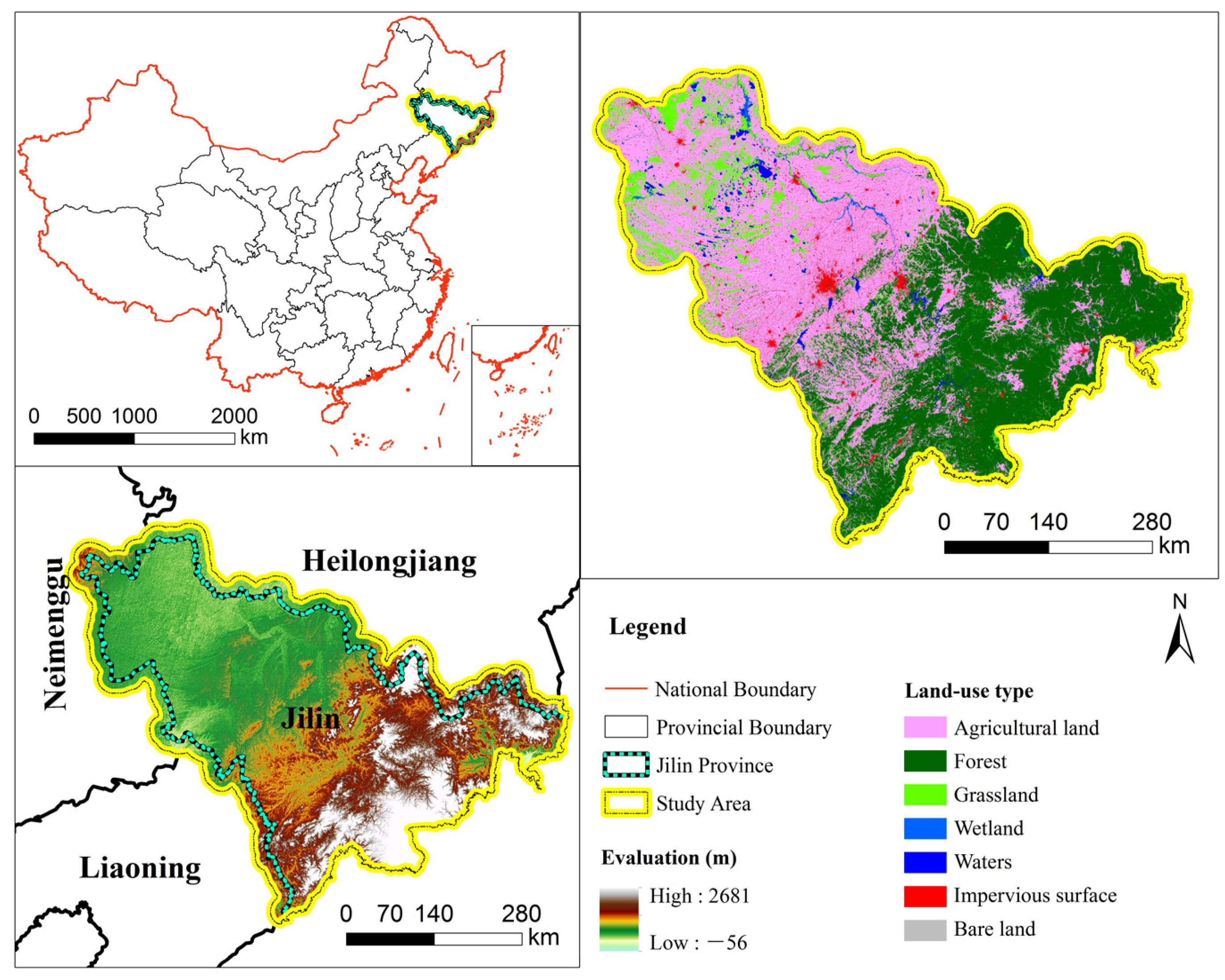


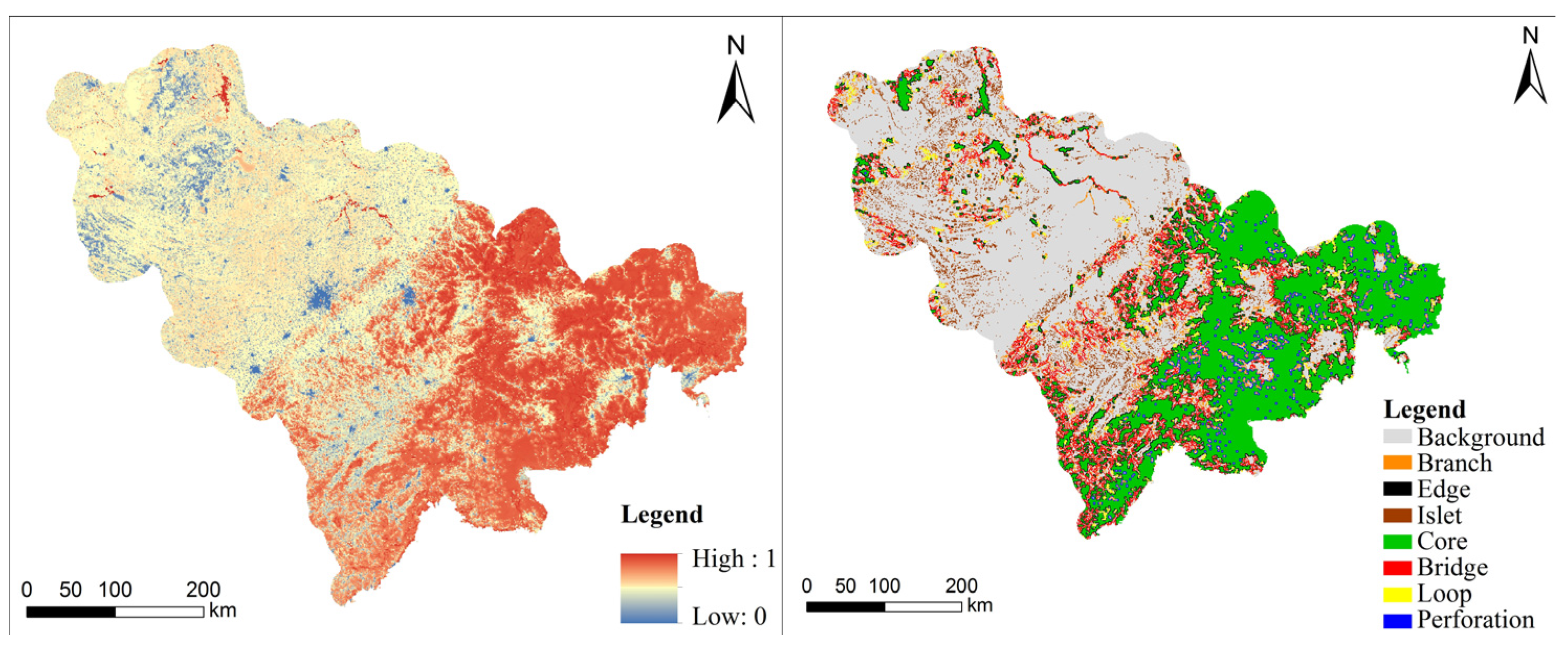
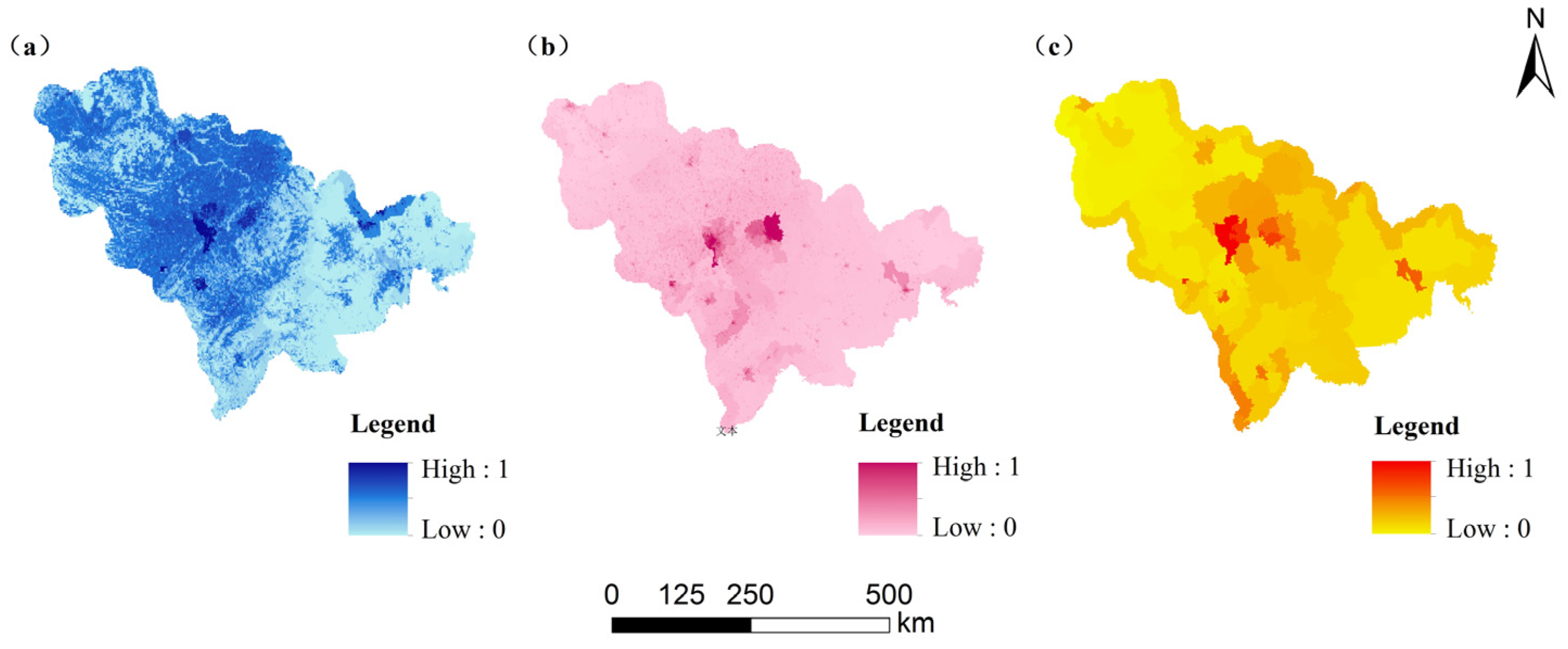


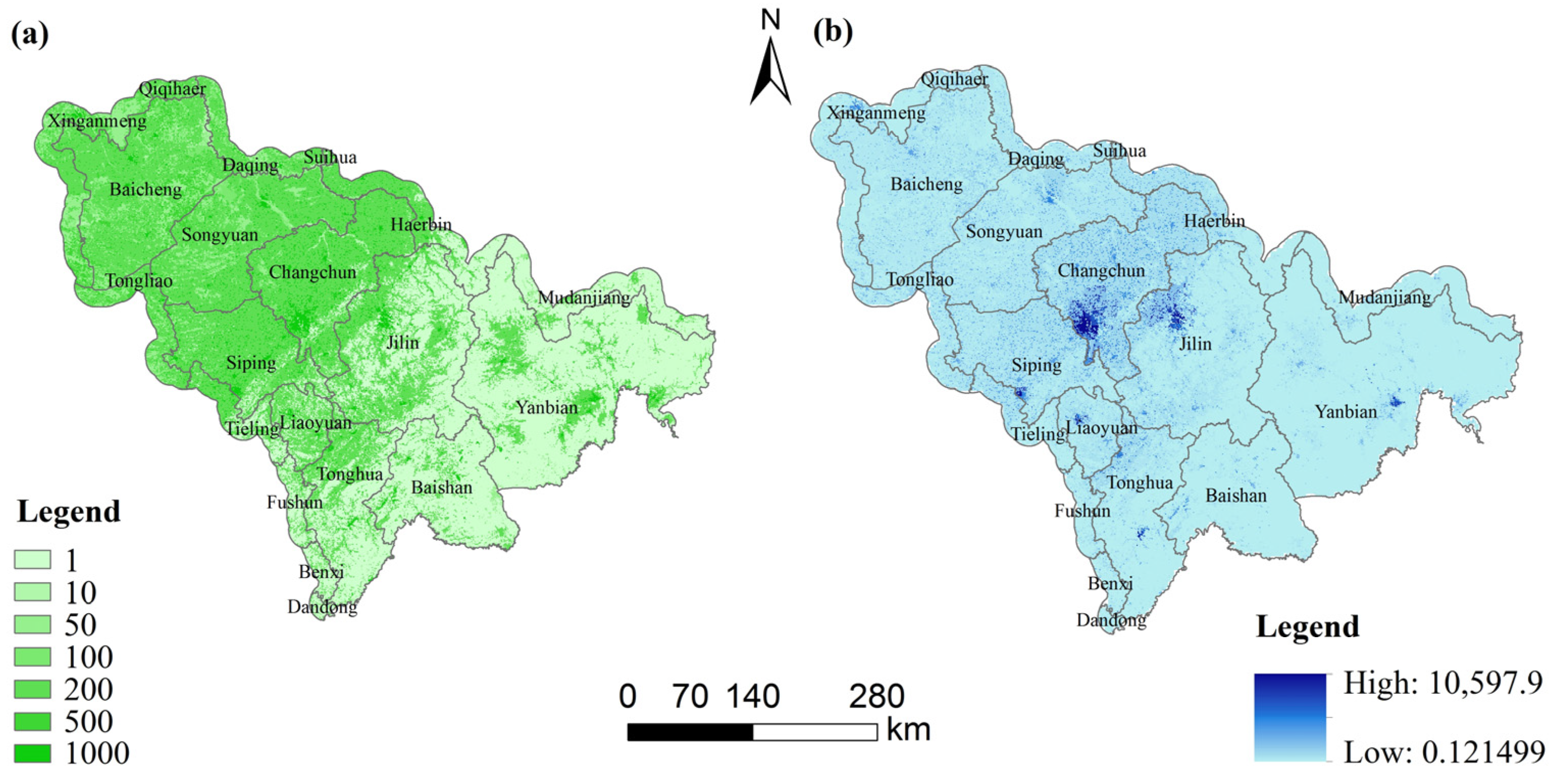
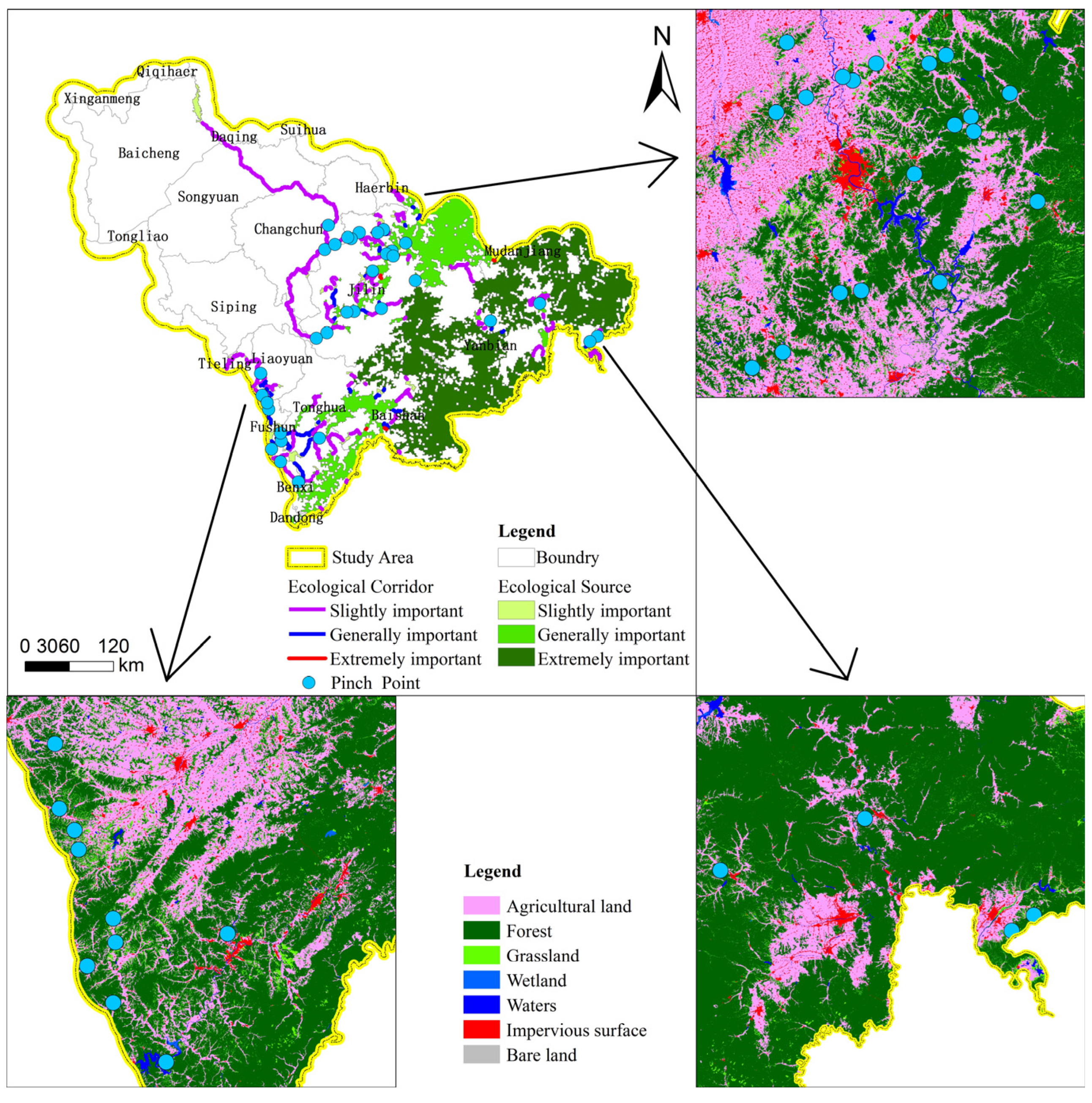



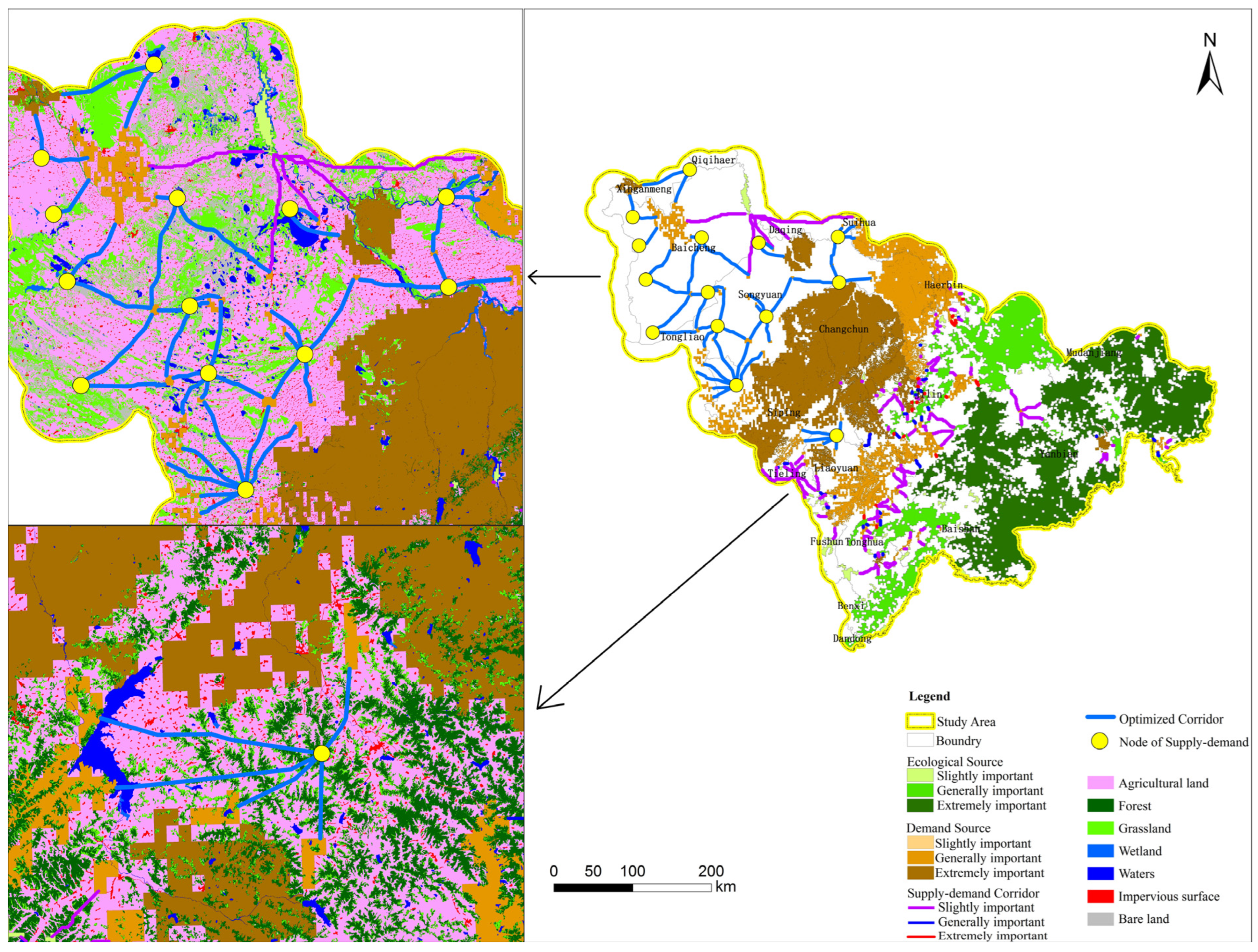
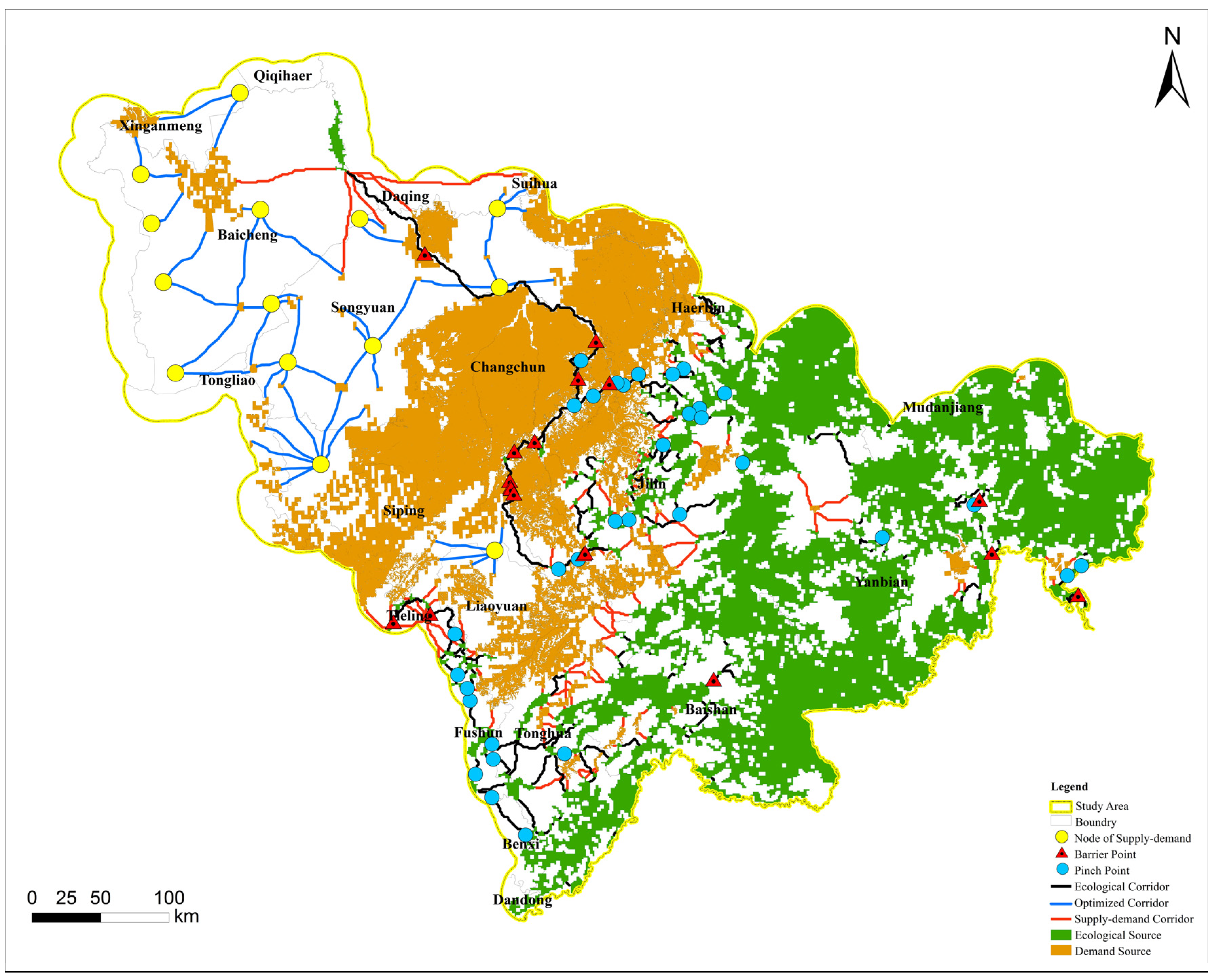
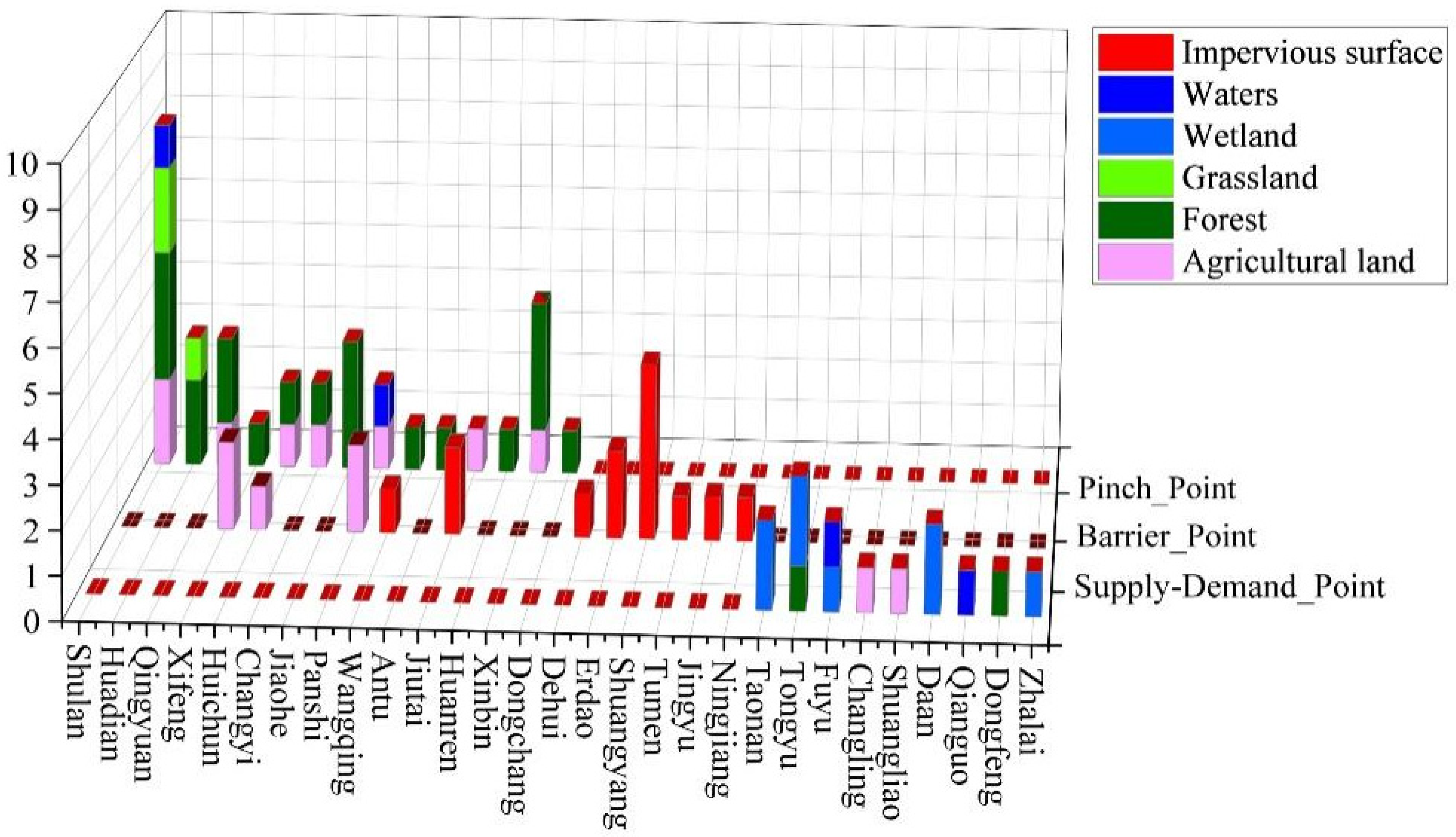
| Data Type | Data Sources | Resolution |
|---|---|---|
| Land use | GLOBELAND30 (http://www.webmap.cn/mapDataAction.do?method=globalLandCover/ (accessed on 1 January 2024)) | 30 m |
| DEM | Geospatial data cloud ASTER GDEM (http://www.gscloud.cn/ (accessed on 1 January 2024)) | 30 m |
| GDP spatial distribution data | National Earth System Science Data Center (https://www.geodata.cn (accessed on 1 January 2024)) | 1 km |
| AOD | National Earth System Science Data Center (https://www.geodata.cn (accessed on 1 January 2024)) | 1 km |
| NPP-VIIRS | https://doi.org/10.3974/geodb.2022.06.01.V1 (accessed on 1 January 2024) | 500 m |
| Root limit layer depth | http://globalchange.bnu.edu.cn/research/cdtb.jsp (accessed on 1 January 2024) | 100 m |
| NPP: MODIS | https://www.earthdata.nasa.gov/search?q=mod17a3 (accessed on 1 January 2024) | 500 m |
| NDVI | National Ecosystem Science Data Center (http://www.nesdc.org.cn/ (accessed on 1 January 2024)) | 30 m |
| Population density dataset | Worldpop (https://www.worldpop.org/ (accessed on 1 January 2024)) | 100 m |
| Road network traffic dataset | Open Street Map (https://www.openstreetmap.org (accessed on 1 January 2024)) | 1 km |
| Available water content of plants | International Soil Reference and Information Centre (ISRIC), Available Soil Water Capacity (volume fraction) | 250 m |
| Soil attribute data | Chinese soil dataset based on the World Soil Database (HWSD) (http://data.tpdc.ac.cn/zh-hans/ (accessed on 1 January 2024)) | 1 km |
| Rainfall data | National Tibetan Plateau Third Pole Environment Data Center.1 km monthly precipitation dataset for China (1901–2022). | 1 km |
| Evaporation data | National Tibetan Plateau Data Center (https://data.tpdc.ac.cn/ (accessed on 1 January 2024)) | 1 km |
| Total energy consumption, GDP, total population, various types of water consumption, etc. | China provincial, city and county statistical Yearbook, China Water Conservancy Statistical Yearbook, etc. | County scale |
| Requirement Categories and Their Corresponding Weights | Ecosystem Service Demand Indicators | Unit | Weight Coefficient | The Corresponding Ecosystem Provides Services |
|---|---|---|---|---|
| primary demand 0.30 | The intensity of carbon emission and oxygen consumption in life | t/km2 | 0.121 | C |
| Density of basic water demand | m3/km2 | 0.052 | B | |
| The density of cultivated land distribution | % | 0.048 | A | |
| Intensity of fertilizer application | t/km2 | 0.048 | A | |
| density of population | Person/km2 | 0.031 | A, B, C, D, E, F | |
| development demand 0.45 | Density of industrial wastewater discharge | t/km2 | 0.060 | B, C |
| Per capita GDP | Wan Yuan/km2 | 0.057 | A, B, C | |
| Density of industrial waste discharges | t/km2 | 0.057 | B, C | |
| Electricity consumption of the land | kWh/km2 | 0.056 | B, C, E | |
| Intensity of carbon emission and oxygen consumption in production | t/km2 | 0.054 | C | |
| The density of investment in fixed assets | Wan Yuan/km2 | 0.039 | C | |
| Density of construction land distribution | % | 0.035 | C, E | |
| The intensity of the night lights | Lm/km2 | 0.035 | C, E | |
| Density of industrial water demand | m3/km2 | 0.019 | B | |
| Intensity of air pollution control needs | /km² | 0.016 | C | |
| Density of secondary industry | % | 0.013 | C, E | |
| density of road network | km/km2 | 0.010 | C, E | |
| advanced demand 0.25 | Density of tourist facilities | One/km2 | 0.091 | F |
| Density of tourist destinations | One/km2 | 0.077 | D, F | |
| The density of tourist numbers | Person/km2 | 0.042 | F | |
| Per capita retail sales of consumer goods | Yuan | 0.032 | A, C | |
| Density of tertiary industry | % | 0.008 | C, F |
Disclaimer/Publisher’s Note: The statements, opinions and data contained in all publications are solely those of the individual author(s) and contributor(s) and not of MDPI and/or the editor(s). MDPI and/or the editor(s) disclaim responsibility for any injury to people or property resulting from any ideas, methods, instructions or products referred to in the content. |
© 2024 by the authors. Licensee MDPI, Basel, Switzerland. This article is an open access article distributed under the terms and conditions of the Creative Commons Attribution (CC BY) license (https://creativecommons.org/licenses/by/4.0/).
Share and Cite
Cai, Y.; Li, H.; Li, W. Optimization of a “Social-Ecological” System Pattern from the Perspective of Ecosystem Service Supply and Demand: A Case Study of Jilin Province. Land 2024, 13, 1716. https://doi.org/10.3390/land13101716
Cai Y, Li H, Li W. Optimization of a “Social-Ecological” System Pattern from the Perspective of Ecosystem Service Supply and Demand: A Case Study of Jilin Province. Land. 2024; 13(10):1716. https://doi.org/10.3390/land13101716
Chicago/Turabian StyleCai, Yuchi, Hong Li, and Wancong Li. 2024. "Optimization of a “Social-Ecological” System Pattern from the Perspective of Ecosystem Service Supply and Demand: A Case Study of Jilin Province" Land 13, no. 10: 1716. https://doi.org/10.3390/land13101716
APA StyleCai, Y., Li, H., & Li, W. (2024). Optimization of a “Social-Ecological” System Pattern from the Perspective of Ecosystem Service Supply and Demand: A Case Study of Jilin Province. Land, 13(10), 1716. https://doi.org/10.3390/land13101716




